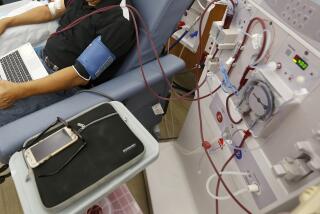Mimicking the kidney
- Share via
People whose kidneys suddenly fail have a grim prognosis. Absent a transplant, more than half will die. Yet the condition is potentially reversible if patients can be kept alive long enough for their organs to recover. An experimental device that mimics kidney function may provide just such a bridge, ultimately saving thousands of lives.
“This is a real advance, and it seems to jump-start the regeneration of failing kidneys,” says Dr. Emil Paganini, a kidney specialist at the Cleveland Clinic Foundation in Ohio who helped test the device.
Every year, nearly 190,000 people suffer an injury or infection that causes their kidneys to stop working. Because the organs are no longer filtering the blood, toxic waste builds up in the body, upsetting the body’s delicate chemical balance and triggering the failure of other organs, such as the lungs, liver and heart.
Even with intensive therapy, which includes standard dialysis, medications and restriction of fluid intake, almost 50% of people with sudden kidney failure die.
The new device, which looks like a conventional dialysis machine, uses human kidney cells to help filter the blood. Blood is first pumped through a standard dialysis filter, then routed through a renal tubule assist device, which is made of hollow fibers lined with living cells. The cells perform critical metabolic functions that standard dialysis machines can’t. These cells also filter toxins; reabsorb vital electrolytes, glucose and water that are removed during dialysis; and regulate production of cytokines, key immune system molecules needed to fight infection.
“The two-stage process mimics the functioning of the kidney,” says Dr. H. David Humes, the inventor of the assist device and a professor at the University of Michigan Medical School in Ann Arbor.
An early test on 10 critically ill patients in an intensive care unit was promising. Tethered to life supports, they were all hovering near death, says Humes. In addition to their kidneys, other organs were failing, and many had systemic infections and serious respiratory problems. More than 80% of patients who are this sick die.
Patients in the study were hooked up to the device for 24 hours, which gave their organs time to heal. Of the six who survived, five recovered completely, and only one needed chronic dialysis therapy. The other four died from complications unrelated to the device. “This was quite compelling because most of the patients weren’t expected to live or do well,” Paganini says.
The device is now is the midst of a larger test, which will eventually involve 100 patients at 10 medical centers across the country. Results of that study should be available next fall. If all goes well, the device could be on the market within the next two years to treat the critically ill.
“It’s taken more than a decade to get this to patients,” says Humes, “but it’s all worth it if it works.”
*
(BEGIN TEXT OF INFOBOX)
New dialysis device works continuously
Chronic kidney failure, which develops slowly over time, poses a different set of hurdles. It’s often caused by high blood pressure and diabetes, and many people don’t realize they have a problem until the kidneys are beyond repair. Treatment for this condition could soon improve as well.
Scientists have developed a prototype battery-powered dialysis machine that may eventually be used around the clock. Right now, these patients must either get a transplant or endure arduous dialysis treatments three times a week.
Between sessions, dangerous toxins accumulate in their blood, which can cause heart disease, high blood pressure and impaired cognitive function, and can shorten life expectancy.
Doing dialysis continuously, instead of for just 12 hours a week, could improve quality of life and significantly reduce mortality rates, says Dr. Victor Gura, a nephrologist at Cedars-Sinai Medical Center in Los Angeles who invented the experimental machine.
The 5-pound device consists of miniature pumps, a fluid collection bag, a dialysis filtration system and disposable cartridges containing key chemicals the body needs, all of which are attached to a belt that can be worn around the waist.
Blood from the patient circulates through a catheter that is split in two and inserted on each end of the device.
Tests last year on 12 pigs, whose kidneys were completely shut down, revealed the device effectively removed waste products and excess fluids from the blood. Researchers hope to begin human tests within the year.






